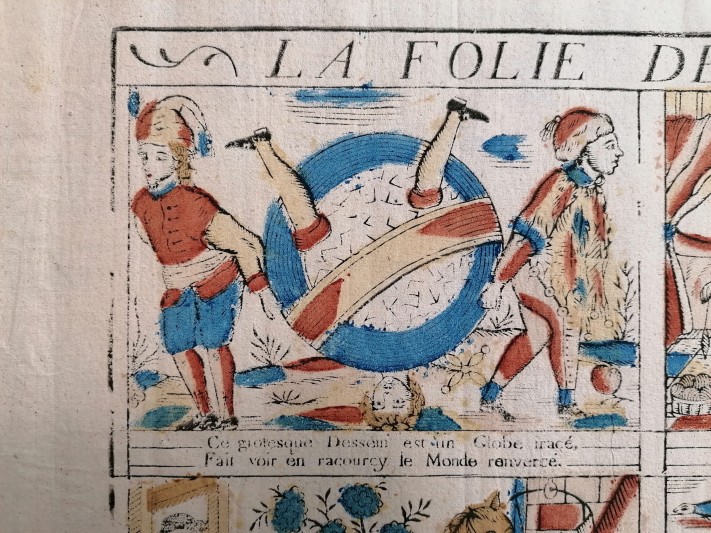Emily Dourish, Deputy Keeper of Rare Books and Early Manuscripts, writes: Cambridge University Library is very grateful to the Friends of the Nations' Libraries for its grant enabling the acquisition of this uniquely surviving example of large format colour printing from pre-Revolutionary France. It comprises a composite sheet of paper almost 1.5 metres long, woodblock printed in four sections and pasted together. The images are charmingly simple, using four colours stencilled over a line drawing with captions explaining the scenes in rhyming couplets explaining the scenes.
Pierre Perdoux was one of the leading printers of decorated papers in Orléans, with the majority of his surviving works being smaller format items on religious subjects, and some 500 examples of papiers dominotés. Only a handful of these oversized prints are preserved; they were frequently used as decoration around fireplaces or on the frame of a bed, and simply disposed of in the fire when soot rendered them too dirty to read. It is believed that this and a handful of other examples have survived as remainders from Perdoux’s workshop, which would explain its excellent condition.
The illustration gives an insight into the structure and characteristics of society in the years just before the French Revolution by presenting the Le Monde à rebours, the world turned upside down. The trope, common since the Middle Ages, is expressed through the order of society and nature being inverted: the son teaches his father to read; the ox is pulled on a cart by two men; buildings are in the sky and the sun and moon drop down to earth. There is a preponderance of horses and donkeys in this particular set of images, suggesting perhaps an interest in the natural world over human politics. Other examples of this large format produced by Perdoux depicted the Great Flood, the Virgin of Sorrows and the Prodigal Son.
The characters of this world turned upside down are depicted in a colour palette which appears on many examples of printing from the period, in what is described as l’imagerie orléanaise. Perdoux’s blocks were reused some 30 years later by Michel Rabier-Boulard, another printer from the same city, suggesting the ongoing appeal of gently mocking established society after the radicalism of the Revolution.
Despite being a prolific printer, with many examples of his work preserved in French museums and libraries, there is only one example of Perdoux’s printing in any of the major UK collections. This unique survival finds a natural home at Cambridge as a complement to our outstanding collection of some 15,000 colour-printed volumes given by Norman Waddleton, covering all subjects and most parts of the world. It will also be an excellent demonstration item for students in our Historical Printing Room, for those studying French politics and society of the Revolutionary period, and for comparison to similar contemporary prints produced elsewhere in Europe at the same time held in our Broadsides collections. The Monde à rebours is available for all to view on the Cambridge University Digital Library.

